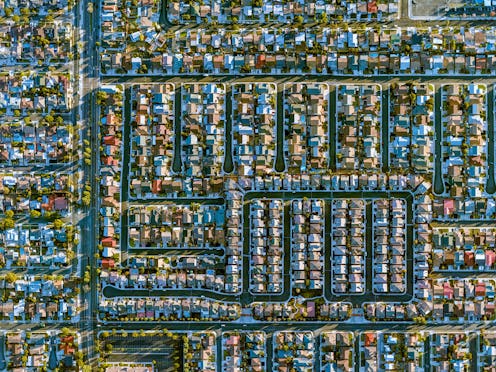News
Artist's Aerial Photos Of L.A. Showcase Inequality

The stark divide between rich and poor is no more evident than in the metropolis of Los Angeles, California. On one side, the impoverished and displaced of the city have attempted to carve out a living for themselves, whether it's on the streets, in temporary public housing, or moving around as their financial and health situations ebb and flow. On the other side of the fence (sometimes almost literally) is an entirely modernized world of glittering billboards, high-priced boutiques, and far too much food waste. It can be hard to comprehend just how closely the two worlds buttress one another sometimes. But luckily, one photographer has taken the initiative. Jeffrey Milstein’s latest aerial photos of Los Angeles aren’t just beautiful and geometric — they speak to the real-life disparities of the average American metropolis.
“There are sort of two extremes in how we end up living based on our affluence,” said Milstein in a recent interview with Fast Company. “It’s very readily apparent from the air, because you suddenly are seeing the differences in the patterns.”
Milstein’s right: As the magazine pointed out, the top five percent of income earners in Los Angeles make 12.5 times more than the remainder of the population combined. And with a population of around 10 million, that means that a lot of people have been left in the dust.
Milstein’s latest project has blindingly exposed that fact. Depicting a palette of Easter-egg-colored mansions on one hand and the leftover remnants of lower-income neighborhoods on the other, the new aerial images, which 71-year-old Milstein snapped from a helicopter hovering above the city, have perfectly summarized the ground-level, dystopian feel of the urban sprawl. He explains to Bustle, "At an altitude of one to two thousand feet, a view unavailable from the ground opens up ... The socio-economics of neighborhoods are evident in the color hue and patterns of the aerial images. The hue shifts from browns toward greens and blues in the increasingly wealthy neighborhoods, which have more trees, pools, and tennis courts, and the roads become more curved."
In the blink of an eye, Milstein says, you’re in a completely new world, where hunger is a myth and you can ger anything that you want.
At the waterfront, the ostentatious display of wealth is disparate. A marina full of private yachts and smaller sailboats gleams brightly in the sun. Set next to public sandy beaches, simple and uncluttered, the income gap seems almost tangible.
Photos of the Downtown regions tell a similarly black-and-white story. Thanks in part to the crackdown on homelessness in the mid 1990s by Los Angeles Police Commissioner William Bratton — a bold, brash leader with plenty of thoughts on the plague of homelessness, particularly on the notoriously impoverished Skid Row — and the gentrification of the low-income regions, which brought in a wealth of real estate investors who bought up affordable housing, thereby kicking up rent prices and flushing out those minimum wage earners who could no longer pay, the divide between the tax brackets has climbed higher and higher.
Milstein’s stunning images capture the glassy shine of towering skyscrapers and manicured landscapes. In opposition, concrete infrastructure and hobbled-together buildings of an era long gone remark in their own language on the crushing burdens of life in the most polarized cities. If ever there were a project to showcase income inequality at its most oppressive, this is it.
“When I was young I had a love of planes and flying,” Milstein says. “My earliest aerial photographs were taken while flying a rented Cessna 150 around Los Angeles as a teenager ... I was fascinated by how everything looked from above."
Later in life, however, he became even more intrigued by the apparent economic differences of those same neighborhoods below, telling Fast Company on Monday that he was especially “struck by the differences in housing.” In his artist's statement, he added:
I was interested in documenting the patterns, layering, and complexity of cities, highlighting airports, container ports, recreational facilities, and residential and commercial developments, all of which grow organically over time and are connected by roads and arterial highways like a living organism. ... The American dream of owning ones own single family home can be seen at one extreme in the most affluent LA neighborhoods, where nearly every house has its own pool and tennis court, often just feet from the neighbors.
With his most recent projects, and his two current shows at New York’s Benrubi Gallery and Los Angeles’ Kopeikin Gallery (which both run through August 22), Milstein is putting that passion to good use in an attempt to dig up and expose the oft-hidden canyon between those with too much and those with too little. By the looks of his latest aerial photos, he found it.
Images: Courtesy of Jeffrey Milstein (6)